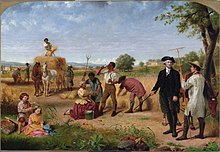Ona Judge
[1] In her early twenties, Judge absconded, becoming a fugitive slave, after learning that Martha Washington had intended to transfer her ownership to her granddaughter, known to have a horrible temper.[a] Her mother, Betty, was enslaved, and her father, Andrew Judge, was a white English tailor working as an indentured servant at Mount Vernon.[10] In 1789, Washington took seven enslaved Africans, including Judge, then 16, to New York City, which was then the nation's capital, to work in his presidential household; the others were her half-brother Austin, Giles, Paris, Moll, Christopher Sheels, and William Lee.With the move of the national capital from Philadelphia to Washington, D.C., there was uncertainty about whether Pennsylvania's slavery laws would apply to officers of the federal government.[17] Giles and Paris left Pennsylvania with him in April; Austin and Richmond were sent back to Mount Vernon before the deadline to prevent them from qualifying for freedom.[18] Moll and Hercules Posey were allowed to remain in Pennsylvania for a couple of days beyond the deadline, then traveled back to Mount Vernon with the First Lady.This one appeared in The Philadelphia Gazette on May 24, 1796: Absconded from the household of the President of the United States, ONEY JUDGE, a light mulatto girl, much freckled, with very black eyes and bushy hair.May 23 Judge was secretly placed aboard the Nancy, a ship piloted by Captain John Bowles and bound for Portsmouth, New Hampshire.Washington knew of Judge's whereabouts by September 1, when he wrote to Oliver Wolcott Jr., the U.S. Secretary of the Treasury, about having her captured and returned by ship.Whipple refused to place Judge on a ship against her will but relayed to Wolcott her offer to return voluntarily to the Washingtons if they would guarantee to free her following their deaths.[23] ... a thirst for compleat freedom ... had been her only motive for absconding.An indignant Washington responded himself to Whipple: I regret that the attempt you made to restore the Girl (Oney Judge as she called herself while with us, and who, without the least provocation absconded from her Mistress) should have been attended with so little Success.To enter into such a compromise with her, as she suggested to you, is totally inadmissible, for reasons that must strike at first view: for however well disposed I might be to a gradual abolition, or even to an entire emancipation of that description of People (if the latter was in itself practicable at this moment) it would neither be politic or just to reward unfaithfulness with a premature preference [of freedom]; and thereby discontent before hand the minds of all her fellow-servants who by their steady attachments are far more deserving than herself of favor.[24]Washington could have used the federal courts to recover Judge — the Fugitive Slave Act of 1793 (which he had signed into law) required a legal process to return an escaped enslaved person over state lines.[30] As a widow, Judge Staines was unable to support her children and moved in with the family of John Jacks Jr.[26] Her daughters Eliza and Nancy became wards of the town and were hired out as indentured servants; her son Will was apprenticed as a sailor.[34] The 153 or so dower slaves at Mount Vernon remained enslaved, as neither George nor Martha could legally free them without reimbursing the Custis estate.The Fugitive Slave Act of 1793 — passed overwhelmingly by Congress and signed into law by Washington — established the legal mechanism by which a slaveholder could recover his property.The Act made it a federal crime to assist an escaped enslaved person or to interfere with their capture and allowed slave-catchers into every U.S. state and territory.




Pennsylvania GazettePhiladelphiaMount VernonColony of VirginiaBritish AmericaGreenland, New HampshireWashington familyGeorge WashingtonPresident's Housefugitive slaveMartha WashingtonNew HampshireChristianityVirginiaJunius Brutus StearnsEnglishindentured servantpartus sequitur ventremDaniel Parke Custisdower shareAlexandria, VirginiaNelly CustisabolitionistNew York CitypresidentialChristopher SheelsWilliam LeeHercules PoseyAn Act for the Gradual Abolition of SlaveryGradual Abolition ActPennsylvaniaslavesU.S. ConstitutionWashington, D.C.Potomac Riverfederal governmentCongressSupreme CourtEdmund RandolphTrenton, New JerseyPennsylvania Abolition SocietyPrigg v. PennsylvaniaWashington's Residence, High StreetJohn Fanning WatsonElizabeth Parke Custis LawJohn Langdon HousePortsmouth, New HampshireBurwell Bassett Jr.Senator John LangdonOliver Wolcott Jr.U.S. Secretary of the TreasuryFugitive Slave Act of 1793Eliza Custis LawmanumittedWilliam CostinGreenlandRockingham County, New Hampshirefree blackindentured servantsapprenticedRockingham CountyForced labourslaveryContemporaryChild LabourChild soldiersConscriptionForced marriageBride buyingChild marriageWife sellingForced prostitutionHuman traffickingInvoluntary servitudePeonagePenal labourContemporary Africa21st-century jihadismSexual slaveryWage slaveryHistoricalAntiquityGreeceMedieval EuropeAncillaeBlack Sea slave tradeByzantine EmpireKholopPrague slave tradeHistoryIn RussiaEmancipationThrallGenoese slave tradeVenetian slave tradeBalkan slave tradeMuslim worldSlavery in the Abbasid CaliphateSlavery in al-AndalusContract of manumissionBukhara slave tradeCrimean slave tradeKhazar slave tradeKhivan slave tradeOttoman EmpireAvret PazarlarıBarbary Coastslave tradepiratesSack of BaltimoreSlave raid of SuðuroyTurkish AbductionsConcubinageMa malakat aymanukumAbbasid haremOttoman Imperial HaremSafavid imperial haremQajar haremCariyeOdalisqueUmm al-waladCircassian slave tradeSaqalibaSlavery in the Rashidun CaliphateSlavery in the Umayyad CaliphateVolga Bulgarian slave trade